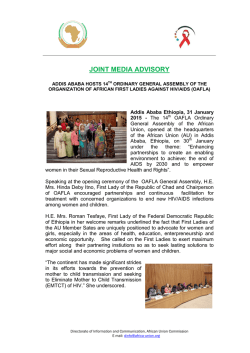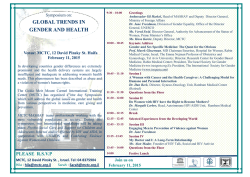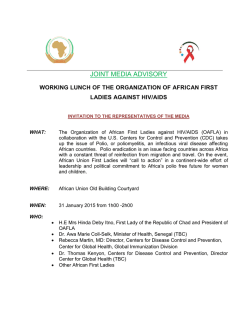
Sex and STD-HIV Education State Laws
GUTTMACHER INSTITUTE STATE POLICIES IN BRIEF As of FEBRUARY 1, 2015 Sex and HIV Education BACKGROUND: Beginning in the 1970s, concerns over teen pregnancy– and later HIV/AIDS– galvanized widespread public support for sex education in schools. Most states today have a policy requiring HIV education, usually in conjunction with broader sex education. Meanwhile, as debate over the relative merits of abstinenceonly-until-marriage versus more comprehensive approaches has intensified, states have enacted a number of specific content requirements. This brief summarizes state-level sex and HIV education policies, as well as specific content requirements, based on a review of state laws, regulations and other legally binding policies. HIGHLIGHTS: General Requirements: Sex Education and HIV Education 22 states and the District of Columbia mandate sex education. 20 states and the District of Columbia mandate both sex education and HIV education. 2 states only mandate sex education. 33 states and the District of Columbia mandate HIV education; of these states, 13 mandate only HIV education. 27 states and the District of Columbia mandate that, when provided, sex and HIV education programs meet certain general requirements. 13 states require that the instruction be medically accurate. 26 states and the District of Columbia require that the information be appropriate for the students’ age. 8 states require that the program must provide instruction that is appropriate for a student’s cultural background and not be biased against any race, sex or ethnicity. 2 states prohibit the program from promoting religion. 37 states and the District of Columbia require school districts to involve parents in sex education, HIV education or both. 22 states and the District of Columbia require that parents be notified that sex education or HIV education will be provided. 3 states require parental consent for students to participate in sex education or HIV education. 35 states and the District of Columbia allow parents to remove their children from instruction. Advancing sexual and reproductive health worldwide through research, policy analysis and public education. 125 Maiden Lane New York, NY 10038 212.248.1111 www.guttmacher.org [email protected] 1301 Connecticut Avenue, N.W. Washington, DC 20036 202.296.4012 www.guttmacher.org [email protected] © 2015, Guttmacher Institute CONTINUED HIGHLIGHTS: Content Requirements When Sex Education is Taught 18 states and the District of Columbia require that information on contraception be provided. 37 states require that information on abstinence be provided. 25 states require that abstinence be stressed. 12 states require that abstinence be covered. 19 states require that instruction on the importance of engaging in sexual activity only within marriage be provided. 12 states require discussion of sexual orientation. 9 states require that discussion of sexual orientation be inclusive. 3 states require only negative information on sexual orientation. 13 states require the inclusion of information on the negative outcomes of teen sex and pregnancy. 26 states and the District of Columbia require the provision of information about skills for healthy sexuality (including avoiding coerced sex), healthy decision making and family communication when. 20 states and the District of Columbia require that sex education include information about skills for avoiding coerced sex. 20 states require that sex education include information on making healthy decisions around sexuality. 11 states require that sex education include instruction on how to talk to family members, especially parents, about sex. Content Requirements When HIV Education is Taught 19 states require information on condoms or contraception. 39 states require that abstinence be included. 27 states require that abstinence be stressed. 12 states require that abstinence be covered. CONTINUED GUTTMACHER INSTITUTE FEBRUARY 1, 2015 GENERAL REQUIREMENTS: SEX AND HIV EDUCATION STATE Alabama Arizona Arkansas California Colorado Connecticut Delaware Dist. of Columbia Florida Georgia Hawaii Idaho Illinois† Indiana Iowa Kentucky Louisiana Maine Maryland Massachusetts Michigan Minnesota MississippiΩ Missouri Montana Nevada New Hampshire New Jersey New Mexico New York North Carolina North Dakota Ohio Oklahoma Oregon Pennsylvania Rhode Island South Carolina Tennessee Texas Utahξ Vermont Virginia Washington West Virginia Wisconsin TOTAL * † ‡ Ω Ψ ξ SEX EDUCATION* MANDATED HIV EDUCATION MANDATED X X X X X X X X X WHEN PROVIDED, SEX OR HIV EDUCATION MUST: Be Be Age Be Culturally Cannot Medically Appropriate Appropriate and Promote Accurate Unbiased Religion X X X X X X X X X X X PARENTAL ROLE Notice Consent OptOut HIV X X X X X X X X X X X X X X X X X X X X X X X X X X X X X‡ X X X X X X X X X X X X X X X X X X X X X X X X X X XΨ X X X X X X X X X X X X X 22+DC X X X 33+DC X X X HIV X X X X HIV X X HIV X X X HIV X X X X X Sex X X X X X X X X X X X X X X X X X X X X X X X X X HIV X X X HIV X X X X X X X X X X X X X X 13 26+DC 8 2 X X X X 22+DC X 3 X X X X X 35+DC Sex education typically includes discussion of STIs. Sex education is not mandatory, but health education is required and it includes medically accurate information on abstinence. Sex education “shall not be medically inaccurate.” Localities may include topics such as contraception or STIs only with permission from the State Department of Education. Sex education is required if the pregnancy rate for 15-17 teen women is at least 19.5 or higher. State also prohibits teachers from responding to students’ spontaneous questions in ways that conflict with the law’s requirements. CONTINUED GUTTMACHER INSTITUTE FEBRUARY 1, 2015 CONTENT REQUIREMENTS FOR SEX* AND HIV EDUCATION STATE Alabama Arizona Arkansas California Colorado Delaware Dist. of Columbia Florida Georgia Hawaii Illinois Indiana Iowa Kentucky Louisiana Maine Maryland Michigan Minnesota MississippiΩ Missouri Montana New Hampshire New Jersey New Mexico New York North Carolina North Dakota Ohio Oklahoma Oregon Pennsylvania Rhode Island South Carolina Tennessee Texas Utahξ Vermont Virginia Washington West Virginia Wisconsin TOTAL WHEN PROVIDED, SEX EDUCATION MUST Contraception Abstinence X Stress Stress Stress Cover Cover Stress X X X X X X Stress Stress Cover Stress Stress Include Information on: Importance of Sexual Negative Sex Only Within Orientation Outcomes Marriage of Teen Sex X Negative X X X Inclusive Inclusive Inclusive X X X X X X X Include Life Skills for: Avoiding Healthy Family Coercion Decision Commun -making ication X X X X X X X X X X WHEN PROVIDED, HIV EDUCATION MUST Include Information on: Condoms Abstinence X X X X X X X Stress Stress Stress Cover Cover Stress Stress Cover Stress Stress Stress Inclusive X X ‡ Cover Stress Stress Cover Stress Cover Stress Stress Cover X X Stress Cover X Stress Cover Stress Stress Stress X X X X X X X Stress Stress Stress Stress Stress Cover Cover Stress Cover Stress 18+DC X X X X X X X X X X X X X X X X X X X X X X X X X X X X X X X X X X X Inclusive Inclusive X X X X X X X Inclusive X X Inclusive Negative X X X X X X X X X X X Negative X X X Inclusive X X 19 12 X X X X 13 19+DC 20 X X X X X X X 11 X X X X Cover Stress Stress Cover Stress Cover Stress Stress Cover Cover Stress Stress Stress Stress Stress Cover Stress Stress Stress Stress Stress Stress Stress Cover Cover Stress Cover Stress 20 * Sex education typically includes discussion of STIs. Ω Localities may include topics such as contraception or STIs only with permission from the State Department of Education. ξ State also prohibits teachers from responding to students’ spontaneous questions in ways that conflict with the law’s requirements. CONTINUED GUTTMACHER INSTITUTE FEBRUARY 1, 2015 FOR MORE INFORMATION: For information on state legislative and policy activity, click on Guttmacher’s Monthly State Update, for state-level policy information see Guttmacher’s State Policies in Brief series, and for information and data on reproductive health issues, go to Guttmacher’s State Center. To see statespecific reproductive health information go to Guttmacher’s Data Center, and for abortion specific information click on State Facts About Abortion. To keep up with new state relevant data and analysis sign up for the State News Quarterly Listserv. Boonstra HD, What Is Behind the Declines in Teen Pregnancy Rates? Guttmacher Policy Review, 2014, 17(3):15-21. Masters NT et al., The opposite of sex? Adolescents’ thoughts about abstinence and sex, and their sexual behavior, Perspectives on Sexual and Reproductive Health, 2008, 40(2):87–93. Boonstra HD, Matter of faith: support for comprehensive sex education among faith-based organizations, Guttmacher Policy Review, 2008, 11(1):17–22. Constantine NA, Jerman P and Huang AX, California parents’ preferences and beliefs regarding school-based sex education policy, Perspectives on Sexual and Reproductive Health, 2007, 39(3):167–175. Kaestle CE and Halpern CT, What’s love got to do with it? Berglas NF et al., A Rights-Based Approach to Sexuality Sexual behaviors of opposite-sex couples through emerging Education: Conceptualization, Clarification and Challenges, adulthood, Perspectives on Sexual and Reproductive Perspectives on Sexual and Reproductive Health, 2014, Health, 2007, 39(3):134–140. 46(2):63-72. Boonstra HD, The case for a new approach to sex education Hasstedt K, The State of Sexual and Reproductive Health mounts; will policymakers heed the message? Guttmacher and Rights in the State of Texas: A Cautionary Tale, Policy Review, 2007, 10(2):2–7. Guttmacher Policy Review, 2014 17(2):14-21. Lindberg LD, Santelli JS and Singh S, Changes in formal Boonstra HD, Lemonade from lemons: the Obama sex education: 1994–2002, Perspectives on Sexual and Administration’s plan for implementing the Title V Reproductive Health, 2006, 38(4):182–189. Abstinence Education Program, Guttmacher Policy Review, 2010, 13(3):24. Dailard C, Legislating against arousal: the growing divide between federal policy and teenage sexual behavior, Boonstra HD, Key questions for consideration as a new Guttmacher Policy Review, 2006, 9(3):12–16. federal teen pregnancy prevention initiative is implemented, Guttmacher Policy Review, 2010, 13(1):2–7. Yarber WL et al., Public opinion about condoms for HIV and STD prevention: a Midwestern state telephone survey, Boonstra HD, Advocates call for a new approach after the Perspectives on Sexual and Reproductive Health, 2005, era of ‘abstinence-only’ sex education, Guttmacher Policy 37(3):148–154. Review, 2009, 12(1):6–11. Eisenberg ME et al., Parent’s beliefs about condoms and oral contraceptives: are they medically accurate? Perspectives on Sexual and Reproductive Health, 2004, 36(2):50–57. GUTTMACHER INSTITUTE FEBRUARY 1, 2015
© Copyright 2025





